Top Surfing Destinations to Explore in June
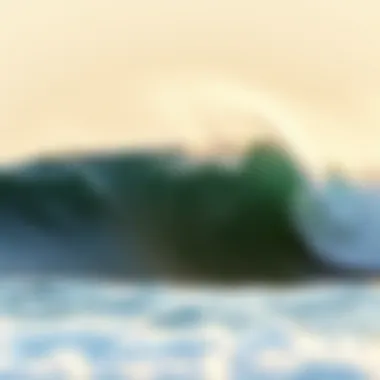
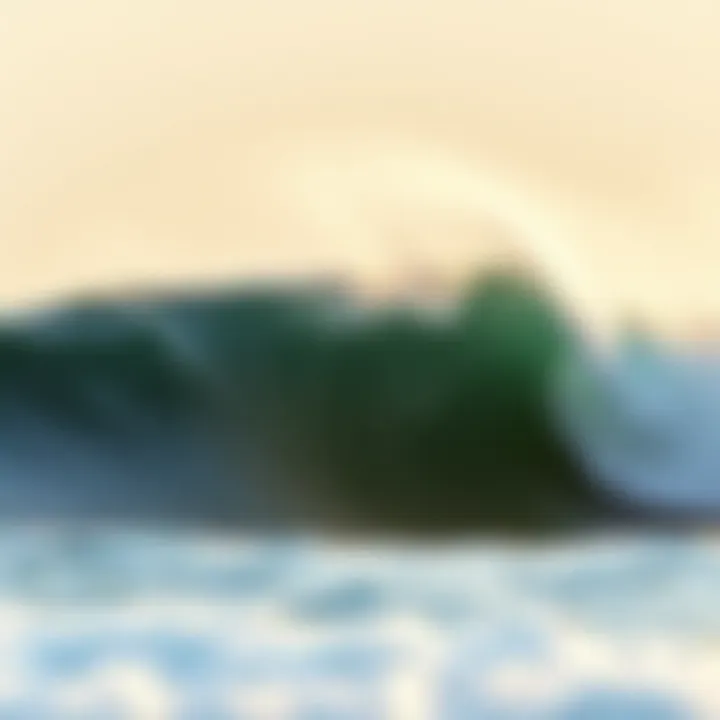
Intro
June marks the sweet spot in the surf calendar for many around the globe. As summer begins to unfold, surf enthusiasts look to the waves with excitement and expectation. From roaring coastlines to serene, beginner-friendly beaches, this month offers diverse options catering to surfers of all skill levels. Understanding the conditions during this period can significantly enhance one's experience, whether you’re paddling out for the first time or chasing that next big wave.
Key elements worth considering include wave quality, local weather patterns, and the cultural vibe of each location. This guide aims to dissect various popular surfing spots geared towards June, giving you a clearer picture of where you should set your sights. Additionally, we will delve into gear and techniques vital for maximizing your time in the water.
By assessing factors like beginner-friendly conditions and accessibility to surf schools, you'll find ideal spots that not only allow for skill development but also promote fun in learning. So, whether you’re looking to bask in the sun or seek surfable swells, let’s navigate through the top choices.
Gear and Equipment
To ride the waves successfully, one must be equipped with the right gear. Surfboards, wetsuits, and the right accessories play a pivotal role in your performance and comfort out on the water.
Latest Surfboard Technologies
Modern surfboards have come a long way from the heavy wood planks of the past. Today’s boards are crafted from high-tech materials designed to optimize performance. For example, EPS foam boards provide lightweight alternatives without compromising strength. Many brands now incorporate carbon fiber and epoxy resins to enhance flexibility and durability, allowing surfers to enjoy better maneuverability and speed.
In June, finding a surfboard that suits the local wave conditions is crucial. Opting for a shorter board might be advantageous in locations with smaller, softer waves, while in places boasting bigger swells, a slightly longer board can provide greater stability.
Essential Accessories for Every Surfer
Equipping yourself with the right accessories can make all the difference:
- Wetsuits: Temperature-sensitive; essential for cold water. Look for options like 3/2mm or 4/3mm thickness, depending on the region.
- Leash: A crucial safety equipment keeping your board attached after a wipeout.
- Wax: A basic yet important item; choose accordingly based on water temperature.
- Sunglasses and Sunscreen: For protection against harmful rays, as summer intensifies.
- Traction Pads: For added grip while performing tricks in the water.
Each piece of equipment enhances not just safety, but also the overall surfing experience.
Surf Techniques and Skills
Beginner Surfing Techniques
For those just starting, the idea of catching your first wave can be daunting. Here are some foundational techniques to get you started:
- Paddling: Learn to paddle efficiently; use long strokes to gain momentum.
- Pop-Up: Practice the pop-up move on the beach. Position yourself flat on the board, press your hands against it, and push yourself into a standing position with quick, fluid movements.
- Positioning: Choose where to sit on the board and how to position yourself in relation to the wave to catch it effectively.
Advanced Maneuvers for Experienced Surfers
Once you’ve mastered the basics, you can take on more complex maneuvers. Consider the following techniques:
- Bottom Turn: Essential for generating speed; this involves carving into the wave as you descend.
- Cutback: A great way to maintain speed and direction while surfing. This involves turning back towards the breaking part of the wave.
- Aerials: These stunts involve launching off the wave and performing tricks before landing back into the water.
As June ushers in more favorable conditions, surfers can capitalize on the warmth and wave patterns to hone their skills. As you engage with the ocean, remember to remain adaptable—conditions can change, and what works one day may not on another.
"Every wave offers an opportunity; learn to seize it, and the ocean will reward you in ways you never thought possible."
Whether you’re a novice finding your footing or a seasoned rider looking to expand your portfolio of moves, this guide is designed to set you up for success, helping to navigate both gear and skills to make the most of your surfing adventures this June.
For additional insights on surfing and technique tips, check out resources at Surfer Magazine or Surfline.
As you gear up for June, this guide aims to lay the groundwork necessary for an unforgettable surfing experience.
Intro to June Surfing
June marks a turning point for surfers around the globe. As summer unfurls its vibrant colors and warm breezes fill the air, surfers find themselves deeply engaged in the watery playground that beckons with open arms. This month often brings together both seasoned riders and eager novices, with the waves calling out to those ready for adventure.
The importance of June in the surfing calendar is multifaceted. For starters, it heralds the arrival of more consistent swell patterns in various regions, particularly at popular coastal destinations. This shift creates an inviting atmosphere for everyone from the layman who’s just picked up a board to the experts aiming to catch the biggest waves of the year.
One of the key benefits of surfing in June is the broad range of options depending on your skill level. Beginners can find suitable beaches with manageable waves and supportive surf schools, while experienced surfers often chase larger sets that develop as the summer solstice approaches. That diversity means that surfers can select locations that cater to their unique needs, making this month an ideal time to hit the waves.
It’s not all about the surf though; local cultures come alive in June, adding a rich layer of experience. Coastal towns often celebrate the warmer weather with festivities, local cuisine, and vibrant markets. This cultural context enhances the experience, allowing surfers to immerse themselves fully. Moreover, understanding surfing seasons lays a foundation for improved surfing conditions. Surf seasons can vary widely based on geographic and climatic conditions, influencing everything from wave size to water temperature.
Understanding Surf Seasons
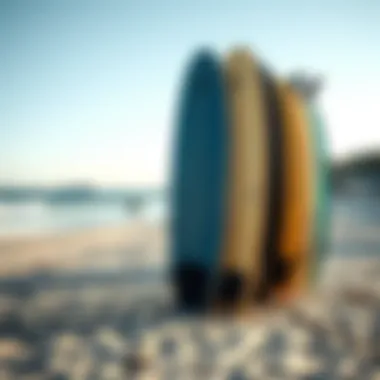

The notion of surf seasons is pivotal in planning a successful surf trip. Every region features its own unique rhythm, dictated by the changing tides and climatic patterns. For instance, the Atlantic Coast sees its peak surf season during late summer and fall, with powerful hurricanes generating thrilling waves. Conversely, June may not deliver the colossal swells that winter storms whip up but can still offer surfing experiences tailored by consistent wind patterns and temperate weather.
Each spot has its own surf season nuances that surfers must take into account:
- Hawaii: Legendary waves typically blossom between November and February, yet June serves as a transitional phase with mellow breaks, perfect for learners.
- California: By June, southern California experiences a swell of activity as beach-goers and surfers alike embrace warmer waters and an uptick in wave production.
- Indonesia: The dry season from May to October presents some of the world’s most pristine surfing conditions, with June often showcasing the early flow of favorable wave patterns.
The essence of understanding surf seasons involves tuning into how these changes affect your chosen spots and ensuring you’re in the right place at the right time.
The Impact of Oceanic Conditions
Oceanic conditions are significant for surfers, as they shape the quality and character of waves. The intricate interplay of tides, swells, and winds defines whether a particular beach will be the ideal surf destination or a no-go zone.
Factors to consider include:
- Wind patterns: Strong onshore winds can chop up waves, rendering them less suitable for surfing. On the other hand, offshore winds often clean up waves, making for a smoother ride.
- Tide Levels: With changing tides, surf breaks can either amplify or dull the quality of the wave. Higher tides can often bury reefs or sandbars, while lower tides might expose them, creating more powerful waves.
- Swells: The origin of swells plays a crucial role. Storms in the distance, especially those forming in the tropics, can lead to remarkable waves. Though June typically lacks the strong swells of earlier months, it can still bring in smaller, surf-friendly waves.
In summary, appreciating oceanic conditions is fundamental to crafting your surfing plans. Understanding how to read these elements allows surfers to select the right beaches and make informed decisions to maximize their experience.
Regional Overview
Understanding the regional differences in surfing destinations offers valuable insights for enthusiasts planning their June excursions. Each coast brings its own unique flavor, and recognizing these variations is paramount for any surfer looking to maximize their experience. With June marking a pivotal time for surf conditions, exploring these regions not only assists in selecting the best waves but also informs surfers about potential environmental and logistical considerations.
The Atlantic Coast
Top Destinations Along the East Coast
When considering the East Coast, spots like Virginia Beach and the Outer Banks stand out. Virginia Beach, with its consistent breaks and vibrant surf scene, caters both to seasoned surfers chasing larger swells and beginners seeking a laid-back environment. Meanwhile, the Outer Banks, with its numerous sandbars, creates varied conditions ideal for surfers of all skill levels. The burgeoning surf culture here is reflected in the local surf schools and community events, making it more than just a surfing spot but a community hub.
Furthermore, one cannot overlook the unique feature of the shifting sandbars along the Outer Banks that can dramatically alter wave size and shape from one day to the next. This variability encourages repeated visits and exploration, appealing to those who thrive on spontaneity and challenge.
Weather Patterns to Expect
June on the Atlantic Coast often brings warm waters thanks to the Gulf Stream, setting up perfect circumstances for a variety of wave conditions. The eastern seaboard frequently experiences swells from the south and east, thanks to trade winds and occasional tropical storms. This can lead to fun, rideable waves for surfers whilst also presenting potential challenges with crowd levels, especially during holidays.
Understanding these weather patterns is key. While the warm air invites a larger crowd, it also means more surfers in the water, increasing the importance of proper etiquette and community respect.
The Pacific Coast
Best Spots in California
Shifting gears to the Pacific Coast, California shines as a premier surf destination. Surf spots like Malibu Beach and Huntington Beach offer famed breaks that have been immortalized in surf culture. California’s long coastline provides myriad conditions from beach breaks to point breaks. Malibu’s iconic right-hand point break, favoring experienced surfers, contrasts with the often more forgiving waves at Huntington, which is friendly to learners.
In June, surfers can expect favorable winds combined with moderate temperatures. The local culture of California's surf scene, rich in history and community, contributes significantly to the allure. However, this popular spot also welcomes dozens of surfers daily, meaning that early mornings or late afternoons may yield a less crowded experience.
Surf Opportunities in Hawaii
Hawaii, the birthplace of surfing, brings forth an iconic experience that is hard to rival. Parks such as Waikiki Beach are family-friendly and perfect for beginners, while North Shore is famous for its powerful waves that attract professionals from around the globe.
The unique aspect of Hawaiian surf culture is the reverence for the ocean and deep-rooted traditions that permeate every session out on the waves. Surfers in Hawaii often enjoy breathtaking landscapes paired with an immersive surf experience, offering both thrill and a connection to nature.
The Indian Ocean
Exclusive Surf Locations in Indonesia
Indonesia is home to some of the most exclusive surf spots in the world. Locations like Bali and Mentawai Islands provide a variety of waves, ranging from mellow swells for beginners to challenging reef breaks that even seasoned surfers often respect. The richness of these surf spots comes from their pristine environments and the ability to escape into untouched nature.
Moreover, Indonesia hosts a surf culture deeply intertwined with local lifestyle and traditions, allowing for a unique surfing experience that’s both thrilling and culturally enriching. However, one must consider the travel logistics and potential challenges of accessing some remote areas, requiring good planning ahead.
Surfing in Madagascar
Often overlooked, Madagascar has started carving out a niche within the surf community. The windswept beaches and shifting sandbanks create a diverse array of waves, suitable for various skills. Moreover, the charm of Madagascar lies not just in its waves but in its semi-remote location which offers surfers a chance to both surf and explore untouched landscapes. The price may be high for travel and accommodation compared to more established surf destinations, but the solitude and adventure on offer are unmatched.
The Southern Hemisphere


Top June Surf Locations in Australia
Australia’s coastline, particularly during June, presents an excellent opportunity for surfers. The Gold Coast stands out, with its famous beaches generating consistent waves perfect for both hardcore wave riders and casual beach-goers. The breathtaking scenery paired with the surfing culture amplifies the experience, making it a must-visit.
Additionally, the unique aspect of Australian surf culture involves an almost collaborative spirit among surfers, wherein local knowledge is widely shared, fostering a welcoming environment. However, surf conditions can vary significantly, and surfers must be mindful of local wildlife.
Understanding the South African Surf Scene
South Africa, with its stunning coastlines like Jeffrey's Bay, is another shining jewel of surf potential. Known for its right-hand point break, Jeffrey’s Bay attracts surfers globally, especially during June when conditions peak. The vibrant surf scene here is distinguished by a mix of local surfers and enthusiastic tourists, contributing to a more dynamic surfing experience.
While the scenery is breathtaking, potential drawbacks include varying crowd levels, which surge during popular waves, highlighting the need for awareness and respect for fellow surfers. Embracing the local surf etiquette ensures a more enriched and less turbulent surfing experience.
Features of Ideal Surfing Locations
When it comes to finding the best surfing spots for June, understanding the features of ideal surfing locations is paramount. This section digs into the nuances that distinguish a great surf destination from a mediocre one. By identifying critical elements such as wave complexity, crowd levels, and environmental considerations, surfers can choose locations that are tailored to their skills and preferences. Navigating the ocean is not just about riding the waves; it’s also about connecting with the natural environment and ensuring a respectful interaction with local cultures.
Wave Complexity
The nature of the waves is arguably the most significant factor for surfers, regardless of their experience level. Wave complexity refers to various aspects of the waves, including their size, shape, and behavior. Some surfers thrive on powerful, barreling waves found in spots like Jeffrey's Bay, while others feel more comfortable with mellow, rolling waves found at beach breaks like those at Lihue in Hawaii.
Specific factors that impact wave complexity include:
- Swells: Seasonal oceanic swells result in powerful and dynamic waves that can vary dramatically based on location and conditions.
- Break Type: Knowing the difference between reef breaks, point breaks, and beach breaks can significantly influence a surfer's experience.
- Tide Effects: The stage of the tide can change the wave's characteristics, making it crucial for surfers to check tidal schedules.
"Not every wave is created equal, and understanding their behavior can mean the difference between a heart-pounding ride and a frustrating tumble."
Choosing a spot with the right wave complexity aligned to one’s skills can elevate a surfing experience from mere sport to an exhilarating dance with nature.
Crowd Levels
When June rolls around, popular surfing destinations can become quite crowded. For both novice surfers and seasoned veterans, crowd levels can significantly impact the enjoyment and safety of their surfing experience.
Surf spots like Trestles in California are famous for their consistent waves but can become a real challenge when swarmed by surfers—especially during peak hours. By contrast, lesser-known beaches may offer fewer surfers and a more relaxed atmosphere, which can be particularly appealing for beginners learning their craft.
Some factors that influence crowd levels include:
- Popularity of Destination: Well-known surfing spots often attract larger crowds.
- Time of Day: Early morning sessions might see fewer people, while afternoons can be hectic.
- Seasonal Changes: Different locations might experience varying levels of crowds based on time of year.
Tips for avoiding abundant crowds:
- Seek out alternative surf spots; there’s often a hidden gem close by.
- Visit during off-peak times or weekdays if possible.
Understanding where the crowds are likely to gather allows surfers to enhance their own experience, carving out their own waves while avoiding unnecessary competition.
Environmental Considerations
The environment of a surfing location carries as much weight as wave quality. From marine life interactions to beach cleanliness and climate sustainability, these factors contribute significantly to the overall surfing experience.
Key environmental elements to consider include:
- Water Quality: Polluted waters can lead to health issues, making it crucial for surfers to check local water quality reports.
- Wildlife Protection: Being aware of local wildlife, including sensitive ecosystems and species protection, is vital.
- Beach Facilities: Quality of amenities like restrooms, showers, and waste disposal can influence comfort levels at a location.
Surfers have a unique relationship with nature, and respecting the environment not only creates a better experience for them but also helps preserve these locations for future generations of enthusiasts.
Accommodation and Local Amenities
Finding the right place to stay and the amenities available at surfing destinations can make or break your June surf trip. Whether you're a seasoned wave rider or a fresh-faced novice, understanding local accommodations and the resources will enhance your overall experience. Good lodging options provide not just a roof over your head but create an inviting atmosphere for relaxation and camaraderie after a day spent battling the surf. Furthermore, local amenities such as surf shops, cafes, and restaurants play a crucial role in shaping your surfing adventure, ensuring that you have the necessary support for both your physical needs and your social desires.
Choosing the Right Lodgings
When planning a surf trip, selecting the appropriate lodging is essential. You have several choices ranging from beachside bungalows to laid-back hostels. Here are some factors to consider:
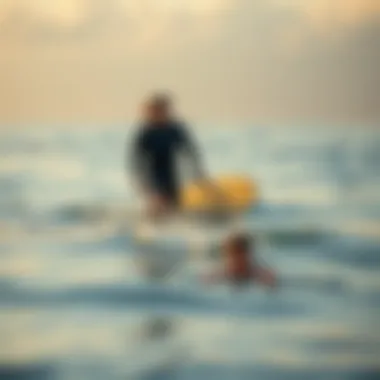
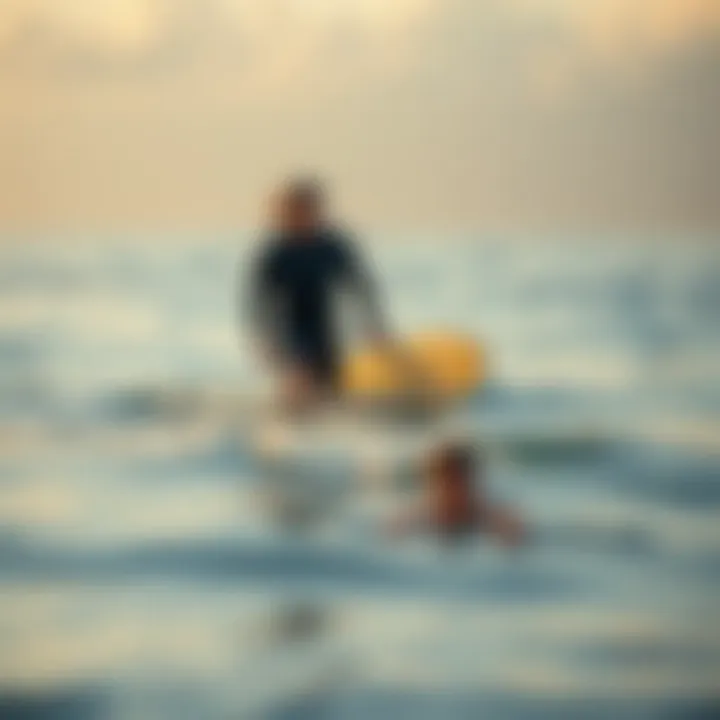
- Location: You want to ensure that your accommodation is conveniently located near good surf spots. Too many early morning drives can sap the joy out of your surfing experience.
- Price Range: Establish a budget beforehand. There are plenty of options depending on what you are willing to spend, from luxury resorts to budget-friendly inns.
- Amenities Offered: Look for facilities like kitchens if you prefer to cook, or check if they provide board rentals at a discount. Some places even have hot tubs, which are perfect for unwinding post-surf.
- Atmosphere: If you're traveling solo or with friends, a social environment can enhance the experience. Choose places known for their community vibes; hostels often offer a mix of relaxation and socializing.
One unique option that surfers might want to explore is surf camps. These camps often provide accommodation, meals, and surfing lessons, neatly packaged for those keen on immersing themselves fully into the surfing lifestyle.
Local Surf Schools
For those new to the surfing scene or even the more seasoned who want to polish their skills, local surf schools can be invaluable.
- Beginner-friendly Instruction: Many schools cater specifically to newcomers, offering step-by-step lessons. Qualified instructors will guide you safely, ensuring you catch your first wave without feeling overwhelmed.
- Gear Rentals: Most surf schools provide equipment rentals, so you don’t have to lug your board from home. This is particularly convenient for travelers who want to keep their luggage light.
- Local Knowledge: Experienced instructors can offer insights into the best surf spots for varying conditions. They often know the spots where the locals surf, helping you avoid crowded areas.
- Community Engagement: Surf schools can also act as a hub for gathering like-minded surfers. Through these schools, you might meet fellow riders, sparking friendships that extend into future trips.
"A well-placed surf spot is only part of the journey. The right stay can elevate the whole experience."
For more information on surfing and accommodations, visit Wikipedia or Reddit.
This covers why accommodation and local amenities are pivotal for surfers during June. With the right choice, surfers can enjoy their experience on and off the waves.
Surfing Etiquette and Cultural Insights
When it comes to riding the waves, understanding surfing etiquette and grasping the cultural fabric of local surf communities can make all the difference in your experience. Both seasoned surfers and newcomers alike risk causing friction by overlooking these unwritten rules. This section delves into the significance of respecting cultural nuances and adhering to established venues, laying a foundation for both a pleasurable surf experience and good fellowship among surfers.
Respect for the Local Surf Community
Respecting the local surf community is paramount for anyone looking to immerse themselves in the surfing culture. Each surf destination has its own set of unwritten rules, often rooted in years of tradition. When you paddle out at a local break, it’s crucial to recognize that surfers who frequent the spot know the waves better than anyone. Here are a few essentials to keep in mind:
- Local Knowledge: Always take the time to observe how local surfers interact and where they take their waves. Every surfer has a feel for the wave, and local surfers often have a deep connection to the area’s surf culture.
- Priority Rules: In many places, there's a priority system—typically, the surfer closest to the peak of the wave gets first dibs. Knowing this can save a lot of embarrassment and keep you from receiving unwanted scorn.
- Avoid Dropping In: Dropping in, or paddling onto a wave being ridden by someone else, is considered a major faux pas. This not only disrupts the ride but could also lead to conflicts. Being aware of the surrounding surfers and the flow of waves can help avoid this.
Additionally, it’s important to acknowledge the unwritten pecking order. If you’re new to a location, staying close to the fringes until you gauge the current dynamics can earn respect and foster goodwill.
Understanding Regional Surf Culture
Diving into the unique regional surf culture enriches your surfing experience. Each locale has its own vibe, community engagement, and surf style. Comprehending these differences can elevate your time spent in the water. For instance:
- Hawaiian Aloha Spirit: In Hawaii, the concept of Aloha embodies more than just greeting; it represents love, respect, and understanding. Local surfers embody this spirit while sharing the lineup. When surfing in Hawaii, embracing gratitude and humility is essential.
- California’s Chill Vibe: On the California coastline, the culture is generally relaxed, with an emphasis on artistic expression. Surfers often accompany their sporting lifestyle with music and creativity, making it a communal experience. Engaging with locals during beach bonfires or surf contests can enhance your cultural understanding.
- Australia’s Laid-Back Attitude: In Australia, surf culture tends to have a welcoming, laid-back attitude. Surfers are usually keen to share tips—especially with visitors willing to follow the local customs. Joining beach clean-ups or local surf events can be a wonderful way to connect.
Tips for First-Time June Surfers
For those who are dipping their toes into the world of surfing for the first time, June offers a sweet opportunity to catch waves, enjoy warm weather, and soak in vibrant beach culture. This section is brimming with wisdom specific to beginners navigating their initial surf adventures. Acquainting oneself with essential gear, understanding the local surf culture, and traversing common hurdles can make all the difference between a memorable day on the water and a battle against frustration.
Essential Gear for Beginners
Having the right equipment can boost confidence for first-timers in the surf. Here are some key items novices should consider:
- Surfboard: Many beginners will opt for a longer, thicker board, especially soft-tops, which offer greater stability and are easier to ride. Brands like Wavestorm and NSP create boards that cater to the starting crowd.
- Wetsuit: Not all waters are tepid in June. A wetsuit can keep one cozy in cooler climates, while still providing a good range of motion. A spring suit might be ideal in warmer locations.
- Leash: It’s sensible to keep the board tied to oneself. A solid leash prevents losing the board in the waves, which can be a safety hazard.
- Rash Guard: Particularly for beginners who may struggle with balance, a rash guard will provide a buffer against skin irritation caused by board contact.
- Sunscreen: Investing in a quality reef-safe sunscreen is crucial. Surfers spend hours in direct sunlight, which can lead to nasty burns if not properly protected.
When stepping into the surf, less can be more. Keeping gear simple allows for focus on mastering the basics instead of worrying about excessive equipment.
Overcoming Common Challenges
First-time surfers face a unique set of challenges that can put a damper on the experience. However, awareness and preparation can ease these obstacles:
- Paddling Techniques: Navigating through water can be real tough. Beginners should practice paddling to ensure they're able to position themselves effectively on the board. Remember, effective paddling is all about using your arms in a smooth motion rather than splashing.
- Wave Selection: Not every wave is equal. Beginners should watch for gentle, broken waves rather than large, crashing volumes. Observing the surf prior to entering is ever so helpful.
- Falling Off the Board: Expect to take a tumble. Falling is a part of learning, and instead of feeling disheartened, embrace it as a step towards mastery. Using techniques like leaning back and keeping arms spread wide can help in minimizing potential injuries upon falling.
- Etiquette Awareness: A newcomer should understand the basics of surf etiquette. This includes giving way to others already riding, avoiding dropping in on someone else's wave, and communicating respectfully within the surf lineup.
The allure of surfing can sometimes lead beginners to throw caution to the wind, but taking these pointers into account can assist them in journeying through that learning curve with more ease. Often, by simply remaining patient and aware, first-time surfers become more confident in their skills and knowledge, setting the stage for enjoyable experiences on the water.
Finale
In wrapping up this discussion on prime surfing spots for June, it's crucial to acknowledge the multifaceted benefits and considerations surrounding the topic. A thorough grasp of optimal surf locations not only enhances the surfing experience but also empowers surfers to make informed decisions tailored to their skill level, interests, and the unique characteristics of various locales. Whether a novice or an experienced rider, understanding wave conditions, weather patterns, and community etiquette remains vital.
Summary of Key Points
As we bring the main aspects of June surfing destinations into focus, several key points stand out:
- Diverse Locations: From the east coast of the U.S. to the shores of Australia, surfers can explore a wide array of geographical varieties, each with unique features and challenges.
- Seasonal Factors: Weather trends and oceanic conditions significantly impact surf quality; hence, June is a window where many locations shine.
- Cultural Significance: Surfing is not just a sport but also a cultural experience. Understanding local customs enriches surf trips and fosters respect among communities.
- Learning Opportunities: Many destinations provide excellent surf schools, catering to first-timers while also pushing experienced surfers to refine their skills.
Future Surfing Trends
Looking ahead, a number of trends may shape how surfers approach their favorite sport. One significant trend is the increasing emphasis on sustainability within surfing communities. Many surfers are becoming more eco-conscious, preferring locations that support environmental initiatives. Additionally, advances in technology are making it easier to access real-time data on surf conditions, which allows surfers to sharpen their skills or find the best spots. Furthermore, a growing number of surf tourism companies are focusing on inclusive experiences that cater to surfers of all abilities.
Keeping a keen eye on these trends, surfers can not only prepare for future adventures but also become more integrated and responsible members of the global surf community.







